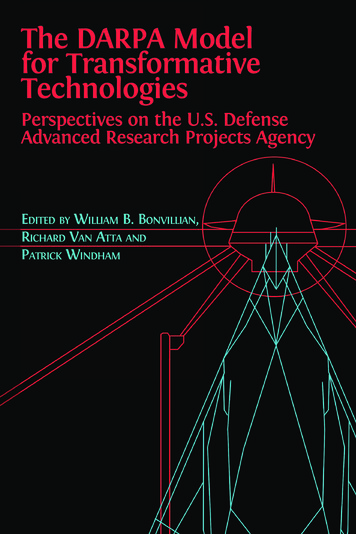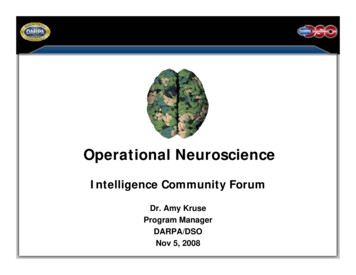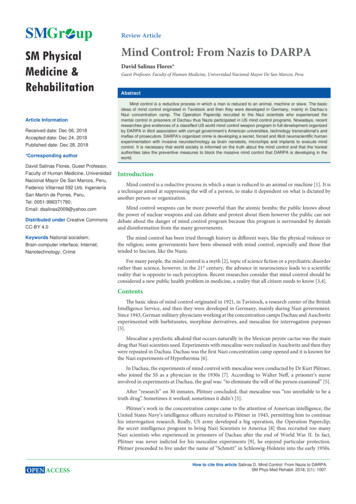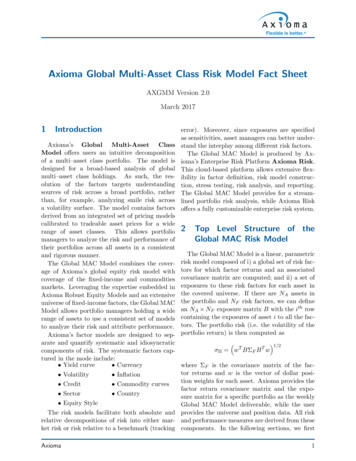
Transcription
The DARPA Modelfor TransformativeTechnologiesPerspectives on the U.S. DefenseAdvanced Research Projects AgencyEDITED BY WILLIAM B. BONVILLIAN,RICHARD VAN ATTA ANDPATRICK WINDHAM
To access digital resources including:blog postsvideosonline appendicesand to purchase copies of this book in:hardbackpaperbackebook editionsGo Open Book Publishers is a non-profit independent initiative.We rely on sales and donations to continue publishinghigh-quality academic works.
THE DARPA MODELFOR TRANSFORMATIVETECHNOLOGIES
The DARPA Model forTransformative TechnologiesPerspectives on the U.S. DefenseAdvanced Research Projects AgencyEdited by William B. Bonvillian,Richard Van Atta, and Patrick Windham
https://www.openbookpublishers.com 2019 William B. Bonvillian, Richard Van Atta, and Patrick Windham. Copyright ofindividual chapters is maintained by the chapters’ authors.This work is licensed under a Creative Commons Attribution-NonCommercial-NoDerivslicense (CC BY-NC-ND). This license allows you to share, copy, distribute and transmitthe text; to adapt the text and to make commercial use of the text providing attribution ismade to the authors (but not in any way that suggests that they endorse you or your useof the work). Attribution should include the following information:William B. Bonvillian, Richard Van Atta, and Patrick Windham (eds.), The DARPA Modelfor Transformative Technologies Perspectives on the U.S.: Defense Advanced Research ProjectsAgency. Cambridge, UK: Open Book Publishers, 2019, https://doi.org/10.11647/OBP.0184In order to access detailed and updated information on the license, please visit, https://doi.org/10.11647/OBP.0184#copyrightFurther details about CC BY-NC-ND licenses are available at, All external links were active at the time of publication unless otherwise stated and havebeen archived via the Internet Archive Wayback Machine at https://archive.org/webUpdated digital material and resources associated with this volume are available athttps://doi.org/10.11647/OBP.0184#resourcesEvery effort has been made to identify and contact copyright holders and any omission orerror will be corrected if notification is made to the publisher.ISBN Paperback: 978-1-78374-791-7ISBN Hardback: 978-1-78374-792-4ISBN Digital (PDF): 978-1-78374-793-1ISBN Digital ebook (epub): 978-1-78374-794-8ISBN Digital ebook (mobi): 978-1-78374-795-5ISBN XML: 978-1-78374-796-2DOI: 10.11647/OBP.0184Cover design: Anna Gatti.
ContentsNotes on ContributorsAcknowledgements1.Introduction: DARPA—The Innovation Iconxixix1Patrick Windham and Richard Van AttaDARPA’s Historical Mission and OrganizationDARPA’s Organization and BudgetImportant Features of the DARPA ModelThe Remainder of this BookReferences29122425PART I: PERSPECTIVES ON DARPA272.29Fifty Years of Innovation and DiscoveryRichard Van AttaThe “DARPA Model”DARPA’s Origins: Strategic Challenges 1958DARPA RolesKey Elements of DARPA’s SuccessTension Between DARPA RolesDARPA’s SuccessesDARPA’s Role in Creating a Revolution in Military AffairsSustaining the DARPA VisionReferences303137373939414243
vi 3.The DARPA Model for Transformative TechnologiesNSF and DARPA as Models for Research Funding: AnInstitutional Analysis45Michael J. Piore, Phech Colatat, and Elisabeth Beck Reynolds4.I. Methodology and Research ApproachII. Basic FindingsIII. InterpretationConclusionsReferences4748677275The Connected Science Model for Innovation—TheDARPA Model77William B. Bonvillian5.Introduction: Fundamentals of Defense TechnologyDevelopmentInnovation Systems at the Personal Level: Great GroupsDARPA as a Unique Model—Combining InstitutionalConnectedness and Great GroupsElements of the DARPA ModelSummaryReferences7798112113The Value of Vision in Radical Technological Innovation1198893Tamara L. Carleton6.The Value of Vision in Radical Technological InnovationConclusionReferences119135136ARPA Does Windows: The Defense Underpinning of thePC Revolution145Glenn R. FongIntroductionPARC and HCIAlto’s OffspringThe Rest of the StoryXerox’s ARPA BratsWindows on the 5
Contents7. Rethinking the Role of the State in TechnologyDevelopment: DARPA and the Case for EmbeddedNetwork Governancevii179Erica R. H. Fuchs1.2.3.4.5.6.8.IntroductionThe Developmental Network StateThe Changing Faces of DARPAMethodsResults and Discussion Discussion: the DARPA Program Manager—EmbeddedNetwork Agent7. 00219DARPA’s Process for Creating New Programs229222223224David W. Cheney and Richard Van Atta9.IntroductionGeneral Framework and Typical Patterns of ProgramDevelopmentCase Studies of the Development of DARPA ProgramsHave Blue (Stealth)Assault Breaker (Standoff Precision Strike)Amber/Predator (High Altitude Long Endurance UAVs)Optoelectronics ProgramHigh Definition SystemsSpintronics (Quantum Computing)Personalized Assistant that Learns (PAL)Topological Data AnalysisRevolutionizing ProstheticsFindings, Conclusions, and Key ObservationsConcluding ThoughtsReferences229233Some Questions about the DARPA rick WindhamReferences297
viii The DARPA Model for Transformative TechnologiesPART II: THE ROLE OF DARPA PROGRAM MANAGERS30110. DARPA—Enabling Technical Innovation303Jinendra RankaThe Role of DARPADARPA and Innovation?Developing and Running DARPA ProgramsImportant Questions to AskTimelinesAdditional Thoughts on Why DARPA is NeededA Flexible and Supportive Agency11. Program Management at DARPA: A Personal Perspective303304306310311312314315Larry JackelGetting New Programs ApprovedSoliciting and Reviewing ProposalsManaging ProgramsIndependence, Responsibility, and Accomplishments316316317318PART III: APPLYING THE DARPA MODEL IN OTHERSITUATIONS32112. Lessons from DARPA for Innovating in Defense LegacySectors323William B. BonvillianConclusion: Innovation in the Defense Legacy SectorReferences13. ARPA-E and DARPA: Applying the DARPA Model toEnergy Innovation354357361William B. Bonvillian and Richard Van AttaOverviewI. The DARPA ModelII. ARPA-E—A New R&D Model for the Department ofEnergyIII. The Remaining Technology Implementation Challengefor DARPA and ARPA-EIV. Conclusion—Brief Summary of Key PointsReferences361365383409426428
Contents14. IARPA: A Modified DARPA Innovation Model ix435William B. BonvillianThe DARPA Model in the Context of Innovation PolicyThe IARPA ModelTwo Challenges to DARPA and its Clones—Manufacturing and Scaling up StartupsConclusionReferences15. Does NIH need a DARPA?436441447449450453Robert Cook-DeeganBiomedical Success455PART IV: CONCLUSIONS46116. Lessons from DARPA’s Experience463Richard Van Atta, Patrick Windham and William B. BonvillianImportant FeaturesCreating New Technical CommunitiesDARPA and the Future464466467Further ReadingDARPA DocumentsGeneral Histories of DARPAHistories of DARPA’s Contributions to InformationTechnology471471471472List of Illustrations and TablesIndex473475
Notes on ContributorsWilliam B. Bonvillian is a Lecturer at MIT, and Senior Director at MIT’sOffice of Digital Learning, leading a project on workforce education. From2006 until 2017, he was Director of MIT’s Washington Office, supportingMIT’s historic role in science policy. He teaches courses on innovationsystems at MIT and is coauthor of three books on innovation, AdvancedManufacturing: The New American Innovation Policies (2018), TechnologicalInnovation in Legacy Sectors (2015), and Structuring an Energy TechnologyRevolution (2009), as well as numerous articles. Previously he workedfor over fifteen years on innovation issues as a senior advisor in the U.S.Senate, and earlier was a Deputy Assistant Secretary of Transportation.He serves on the National Academies of Sciences’ standing committeefor its Innovation Policy Forum and chairs the Committee on Science andEngineering Policy at the American Association for the Advancement ofScience (AAAS). He was elected a Fellow of the AAAS in 2011. He has aBA from Columbia, an MAR from Yale and a JD from Columbia.Tamara Carleton, PhD, is the CEO and founder of InnovationLeadership Group LLC and lead author of the Playbook for StrategicForesight and Innovation (2013), a hands-on guide that has been usedby hundreds of the world’s most innovative companies to make theirteams more successful. She is the executive director of the Silicon ValleyInnovation Academy at Stanford University and a visiting professorat the Osaka Institute of Technology in Japan. Previously she was anInnovation Fellow with the US Chamber of Commerce Foundation, aFellow with the Bay Area Science and Innovation Consortium, and aFellow at the Foundation for Enterprise Development. She has workedas a management consultant at Deloitte Consulting LLP, specializing
xii The DARPA Model for Transformative Technologiesin innovation, customer experience, marketing strategy, and enterpriseapplications. A multidisciplinary scholar, Dr. Carleton holds a doctoratein mechanical engineering from Stanford University, a master’s ofscience from Syracuse University, and a bachelor’s degree from TheGeorge Washington University.David W. Cheney is a consultant and Managing Partner of TechnologyPolicy International, a firm that provides analyses of science, technology,and innovation policy. He is the former Director of the Center forScience, Technology and Economic Development at SRI International,where his work focused on planning and evaluating science, technology,and innovation programs and institutions, primarily in the UnitedStates and Middle East. He is also a consultant to the World Bank andhas been an adjunct professor at George Mason University. Beforejoining SRI in 1998, he was a senior executive in the U.S. Department ofEnergy, serving as director of the Secretary of Energy Advisory Boardand advisor to the Deputy Secretary on industrial partnerships andnational laboratories. He previously was a senior associate with theCouncil on Competitiveness, and an analyst with the CongressionalResearch Service. He has also held positions with the Internet PolicyInstitute, the Optoelectronics Industry Development Association, theCompetitiveness Policy Council, and the Institute for Policy Science atSaitama University in Japan. He has a PhD in public policy from GeorgeMason University, a MS in Technology and Policy from MIT and a BS inGeology & Biology from Brown University.Phech Colatat is Assistant Professor of Strategy at the Olin BusinessSchool, Washington University in St Louis. He is a business schooltrained sociologist with interests in healthcare, R&D, and strategicmanagement. Motivated by alarming trends in the prevalence ofautism spectrum disorder (ASD), his current research examines theway organizational and social network processes affects the diagnosticprocess. He completed his PhD at the MIT Sloan School of Management.Robert Cook-Deegan, PhD, is a professor in the School for the Futureof Innovation in Society, and with the Consortium for Science, Policyand Outcomes at Arizona State University. He founded and directedDuke’s Center for Genome Ethics, Law & Policy (2002-12), and
Notes on Contributors xiiiDuke-in-Washington through June 2016. Prior to Duke, he was withthe National Academies of Science, Engineering and Medicine (19912002); National Center for Human Genome Research (1989-90); andcongressional Office of Technology Assessment (1982-88). His researchinterests include science policy, health policy, biomedical research,cancer, and intellectual property. He is the author of The Gene Wars:Science, Politics, and the Human Genome (1994) and more than 250 otherpublications.Glenn R. Fong is an associate professor of global studies at ThunderbirdSchool of Global Management. He is also the academic director of theschool’s Master of Arts in Global Affairs and Management. His areasof expertise include technology, global trade and industrial policiesof the U.S., Japan and China, government and business relations andinternational political economy. Of Chinese-American ancestry, Fonghas contributed commentaries and monographs to Business and Politics,Issues in Science and Technology, International Security, InternationalStudies Quarterly, Comparative Politics, and the Journal of Policy Analysisand Management. In 1996, Fong authored Export Dependence vs. the NewProtectionism: Trade Policy in the Industrial World. He has served as aconsultant to the National Academy of Sciences, the U.S. CongressionalOffice of Technology Assessment, Japan’s Ministry of InternationalTrade and Industry (now METI), and IBM Corporation’s e-BusinessTechnology division. He earned his BA at the University of California,Berkeley, and MA and PhD degrees in government from CornellUniversity. Earlier in his career, he was an assistant professor at theUniversity of Illinois-Chicago and a postdoctoral research fellow atHarvard University’s Graduate School of Business Administration.Erica R. H. Fuchs is a Professor in the Department of Engineering andPublic Policy at Carnegie Mellon University, and a Research Associatewith the National Bureau of Economic Research. Her research focuseson the development, commercialization and global manufacturingof emerging technologies, and national policy in that context. Shewas the founding Faculty Director of Carnegie Mellon University’sManufacturing Futures Initiative—an initiative across six schoolsaimed to revolutionize the commercialization and local productionof advanced manufactured products. Over the past decade, Dr. Fuchs
xiv The DARPA Model for Transformative Technologieshas played a growing role in national and international meetings ontechnology policy, including being one of twenty-three participantsin the President’s Council of Advisors on Science and Technologyworkshop that led to the creation of the Advanced ManufacturingPartnership, and serving on the expert group that supported the WhiteHouse in the 2016 Innovation Dialogue between the U.S. and China. In2012 she was selected a World Economic Forum “Young Scientist” (top40 under 40 globally.) She currently serves on the National Academies’National Materials and Manufacturing Board; the Academic AdvisoryBoard for MIT’s Institute for Data, Systems, and Society, of which MIT’sTechnology Policy Program is a part; the World Economic Forum’sFuture of Production Global Futures Council; and the Advisory EditorialBoard for Research Policy. Before coming to CMU, Dr. Fuchs completedher PhD in Engineering Systems at MIT in June 2006. She received herMasters and her Bachelor’s degrees also from MIT in Technology Policy(2003) and Materials Science and Engineering (1999), respectively. Dr.Fuchs spent 1999-2000 as a fellow at the United Nations in Beijing,China. She grew up and attended K-12 in the Reading Public SchoolDistrict in Reading, PA. Her work has been published among otherplaces in Science, the Nature journals, Research Policy, and ManagementScience; and has been covered on National Public Radio, by Bloomberg,and in the New York Times.Larry Jackel is President of North-C Technologies, where he doesprofessional consulting in robotics and machine learning. He alsocurrently serves as a Learning Advisor to the Stanford ArtificialIntelligence Lab (SAIL)-Toyota Center for AI Research at StanfordUniversity. From 2003-07 he was a DARPA Program Manager in the IPTOand TTO offices. He conceived and managed programs in AutonomousGround Robot navigation and Locomotion. For most of his scientificcareer Jackel was a manager and researcher in Bell Labs and then AT&TLabs. Members of Jackel’s Adaptive Systems Department at Bell Labslaid the foundation for much of the machine learning that dominates AItoday. He has also created and managed research groups in microscienceand microfabrication, and in carrier-scale telecom services. Jackel was afounder of the Snowbird Workshop on Neural Networks for Computerand led the workshop many years. He was also a founder of the NIPS
Notes on Contributors xvconferences. He has served as Program Chair for IJCNN. He has alsobeen an organizer of the Frontiers in Distributed Information Systems(FDIS) workshop series. Jackel holds a PhD in Experimental Physicsfrom Cornell University with a thesis in superconducting electronics.He is a Fellow of the American Physical Society and the IEEE. He haspublished over 150 papers and has over twenty patents.Michael Piore has been on the faculty of the Department of Economicsat MIT since 1966, and also currently holds a joint appointment with theDepartment of Political Science. He is also currently a Visiting SeniorFellow in International and Public Affairs at the Watson Institute forInternational and Public Affairs at Brown University. He earned hisundergraduate and graduate degrees at Harvard University, where hewrote his doctoral dissertation under the direction of John T. Dunlop.He is the founding director of the MIT-Mexico Program and formerassociate director of the Center for Technology, Policy and IndustrialDevelopment. He has served as president of the Society for theAdvancement of Socio-Economics (SASE) and as an elected memberof the executive committee of the American Economic Association. Hewas a MacArthur Prize Fellow (1984-89), a member of the ExecutiveCommittee of the American Economic Association (1990-95), and amember of the Governing Board of the Institute for Labour Studies ofthe International Labour Organization (1990-96).Jinendra Ranka, PhD, has over twenty-five years of experience inacademic, commercial, and government research and development.He was a technical staff member at Bell Labs, Sycamore Networks, andMIT Lincoln Laboratory, and is currently the CEO at JASR Systems.Dr. Ranka served as a program manager in the Strategic TechnologyOffice at DARPA and as a Deputy Office Director at IARPA. He has over40 publications with over 5,000 citations and numerous patents. Dr.Ranka received his Doctoral degree in Applied & Engineering Physicsfrom Cornell University in 1997 and his Bachelor of Science degreein Electrical Engineering from the California Institute of Technologyin 1991. Dr. Ranka is a fellow of the Optical Society of America andis known for his discovery of supercontinuum generation in opticalfibers.
xvi The DARPA Model for Transformative TechnologiesElisabeth B. Reynolds is the executive director of the MIT IndustrialPerformance Center and a lecturer in MIT’s Department of Urban Studiesand Planning. Reynolds works on issues related to systems of innovation,regional economic development, and industrial competitiveness. She isa member of the Massachusetts Advanced Manufacturing Collaborativeas well as the Northeast Clean Energy Council. Her current researchfocuses on the pathways that U.S. entrepreneurial firms take in scalingproduction-related technologies, as well as advanced manufacturing,including the globalization of the biomanufacturing industry. Beforecoming to MIT for her PhD, Reynolds was the director of the CityAdvisory Practice at the Initiative for a Competitive Inner City (ICIC),a non-profit founded by Professor Michael Porter, focused on job andbusiness growth in urban areas. Reynolds has an AB from Harvard ingovernment and was a Fiske Scholar at Trinity College, Cambridge. Sheholds an MSc from the University of Montreal in economics and a PhDfrom MIT in urban and regional studies.Richard Van Atta’s career has focused on the national security policy,strategy, and technological capabilities of the United States for theDepartment of Defense, chiefly for the Office of the Secretary of Defenseand the Defense Advanced Research Projects Agency, the Office ofScience and Technology Policy (OSTP) of the White House, and theIntelligence Community. From 1983 to his retirement in 2018, he wasa senior research staff member of the Strategy, Forces and ResourcesDivision (SF&RD), the Science and Technology Policy Institute (STPI)and the Science and Technology Division at the Institute for DefenseAnalyses (IDA), with a focus on innovation for national security. Hiswork at IDA included assessments of the programs and developmentstrategies of the Defense Advanced Research Projects Agency (DARPA).From 1993 to 1998, he served as Assistant Deputy Under Secretaryof Defense for Dual Use and Commercial Programs (on temporaryassignment from IDA). He also was an adjunct faculty member inGeorgetown University’s Security Studies Program and the Science,Technology and International Affairs (STIA) program teaching courseson Emerging Technology and Security. Dr. Van Atta has a PhD inPolitical Science from Indiana University and a BA degree in PoliticalScience from the University of California, Santa Barbara.
Notes on Contributors xviiPatrick H. Windham is a Lecturer in the Public Policy Program atStanford University and a Partner with Technology Policy International,a consulting firm. In the past he has taught at the University ofCalifornia’s Washington, DC, center and the University of Maryland.From 1984 until 1997 he served as a Senior Professional Staff Memberfor the Subcommittee on Science, Technology, and Space of the UnitedStates Senate’s Committee on Commerce, Science, and Transportation.He helped Senators oversee and draft legislation for several majorcivilian science and technology agencies and focused particularly onissues of science, technology, and U.S. industrial competitiveness. Hehas served on five committees and roundtables of the U.S. NationalAcademies. Mr. Windham received a BA from Stanford University anda Master of Public Policy degree from the University of California atBerkeley.
AcknowledgementsThe editors are grateful to the authors who have contributed to thisvolume, and to the publications that originally published their articlesand which have agreed to have them reprinted in this volume; each isacknowledged at the outset of each chapter.Second, the editors wish to thank Peter L. Singer who provided greatassistance in compiling this volume.Third, the editors acknowledge and thank colleagues in Japan. Thisbook is in part based on a briefing book prepared for a workshop atthe National Graduate Institute for Policy Studies (GRIPS) in Tokyoon 25 February 2014. This workshop focused on lessons to be learnedfrom the DARPA model as Japanese officials considered the structureof a DARPA variant. The authors particularly wish to thank ProfessorAtsushi Sunami, who organized that event. Several of the Americanauthors of this book, including all three editors, participated in theworkshop.The editors also wish to thank the many colleagues and current andformer DARPA officials who have provided valuable insights into howDARPA works. They also thank ARPA-E and IARPA former officials fortheir insights.The editors thank their families for their support and patienceas their various studies of DARPA were ongoing. Finally, PatrickWindham wants to particularly thank his spouse, Dr. Arati Prabhakar.In the interest of full disclosure, the editors want to note that Dr.Prabhakar served as the Director of DARPA from July 2012 to January2017. However, Dr. Prabhakar was not involved in the creation of thisbook and the viewpoints expressed here should not be construed asrepresenting her views or those of DARPA.
1. Introduction:DARPA—The Innovation IconPatrick Windham and Richard Van AttaThe Defense Advanced Research Projects Agency (DARPA) has becomean “innovation icon,” widely recognized for playing an importantrole in the creation and demonstration of many new breakthrough(“disruptive”) technologies. Some of these technologies have strictlymilitary applications, such as stealth and precision-guided munitions.Others are “dual-use technologies” that have benefited both the civilianworld and the Department of Defense. Examples of these technologiesinclude the Internet, Global Positioning System (GPS) receivers,voice recognition software, advanced semiconductor manufacturingprocesses, and un-manned aerial vehicles. It is a remarkable record.This introductory chapter focuses on DARPA’s key features—itsmission, organization, linkages to other organizations, and “politicaldesign”—and how those features have contributed to its success. Laterchapters and the book’s Conclusion suggest some lessons that DARPA’sexperience offers for those interested in how this organization hasworked over nearly sixty years and for those seeking to create similartechnology agencies. P. Windham and R. Van Atta, CC BY-NC-ND 4.0 https://doi.org/10.11647/OBP.0184.01
2 The DARPA Model for Transformative TechnologiesDARPA’s Historical Mission and OrganizationDARPA’s EvolutionDARPA has existed for over sixty years and during that time it hasevolved, changed, and, on a couple of occasions, come close to beingdissolved. It has changed in its organizational structure and in someimportant operational mechanisms as well. There is no simple singulardepiction of DARPA that is accurate because it has changed and adaptedbased on how the world around it has changed—especially on how thenational security environment has changed, but also on what differentPresidents and their Administrations have asked of it.Importantly, even at a given point in time there are what might betermed several DARPAs, as different parts of the organization—as smallas it is—have focused on very different things—both technologicallyand in terms of how they function. This is evident from its early history,as Richard Van Atta outlines:Indeed DARPA has morphed several times. DARPA has “re-grouped”iteratively—often after its greatest “successes”. The first such occasionwas soon after its establishment, with the spinning off of its spaceprograms into NASA. This resulted in about half of the then ARPApersonnel either leaving to form the new space agency, or returning to amilitary service organization to pursue military-specific space programs.A few years later, then DDR&E John S. Foster required ARPA totransition its second largest inaugural program—the DEFENDER missiledefense program—to the Army, much to the consternation of some keymanagers within ARPA. Also early in its history ARPA was tasked toconduct a program of applied research in support of the military effortin Viet Nam.1Thus, even by the early 1960s one could say there were three, perhapsfour key DARPA thrusts—with the addition of its exploration of new,emerging technologies, such as materials, and the nascent informationtechnologies. As the overview below shows, DARPA’s history hasbeen perturbed by political dynamics as well as the dynamics of thetechnologies it has pursued. Perhaps the most important hallmark of1 Van Atta, R. (2008). “Fifty Years of Innovation and Discovery”, in DARPA, 50 Yearsof Bridging the Gap, ed. C. Oldham, A. E. Lopez, R. Carpenter, I. Kalhikina, and M. J.Tully. Arlington, VA: DARPA. 20–29, at 25, https://issuu.com/faircountmedia/docs/darpa50 (Chapter 2 in this volume).
1. Introduction 3DARPA has been its adaptability and flexibility to respond to changingcircumstances—often extremely rapidly.DARPA’s Origins: 1958–1970In October 1957, the Soviet Union launched the first artificial satellite,Sputnik I, an accomplishment that shocked the United States. ManyAmericans worried that the country was losing technological leadershipto its Cold War adversary.After the launch of Sputnik, President Dwight Eisenhower followedthe advice of Secretary of Defense Neil McElroy and leading scientists,including his science advisors, James Killian and then Dr. GeorgeKistiakowsky, and proposed the creation of what became the AdvancedResearch Projects Agency (ARPA). ARPA was formed just four monthsafter Sputnik on 7 February 1958 through DOD Directive 5105.15 bySecretary McElroy.2 Herbert York, a Manhattan Project veteran andthe first director of the Lawrence Livermore Laboratory, helped guidethe early evolution of ARPA as its first Chief Scientist and then as theDefense Department’s first Director of Research and Engineering.Initially, the agency focused on three key assignments from thePresident: space, missile defense, and the detection of nuclear weaponstests. Eisenhower subsequently made it clear that space was to be therealm of a civilian agency, and later, in 1958, Congress and the Presidentcreated the National Aeronautics and Space Administration (NASA), acivilian agency which took over the country’s principal space programs,absorbing much of DARPA’s Space Program. The two other Presidentialassignments—missile defense and nuclear test detection—continued asthe dominant foci for about fifteen years but eventually were moved toother parts of the Department of Defense (DOD).Also, soon after its founding ARPA took on Project AGILE, asproposed by its Deputy Director, William Godel, which was a decadelong classified program supporting U.S. combat efforts in Vietnam andbeyond. In retrospect, much of AGILE was naive, poorly managed and2 ongress, through an amendment by Senator Mike Mansfield, renamed “ARPA”Cas “DARPA” in 1972, adding the word “Defense.” Congress, through Senator JeffBingaman, renamed it “ARPA” again in February 1993, because of its “dual-use”role in creating technologies with commercial as well as military applications. Thename reverted to “DARPA” in March 1996.
4 The DARPA Model for Transformative Technologiesrife with amateurism. The ARPA Directors had little access or knowledgeof what AGILE was doing as Godel “was running the AGILE office as hisown covert operations shop”.3 There were important lessons learnt fromAGILE (as a program run amok, with little oversight) on what not to do.It was hardly scientific and as an operational program it focused on nearterm solutions. It became a key element in defining what DARPA wouldnot be in the battle over competing visions for the agency’s future.With the quick transfer of the space program to NASA, ARPA spentthe rest of the decade focused on missil
Foresight and Innovation (2013), a hands-on guide that has been used by hundreds of the world’s most innovative companies to make their teams more successful. She is the executive director of the Silicon Valley Innovation Academy at Stanford University and a visiting professor at the Osaka Institute of Te










